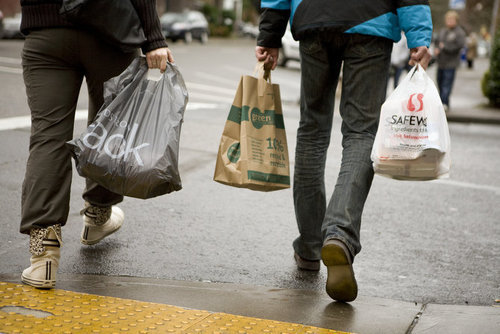7 Steps to Make Your Grocery Store more Sustainable (and more in-tune)
In a newly released study conducted In August of 2014, Gibbs-rrb interviewed over two thousand adults to assess the impact of sustainability on grocery buying habits. Not surprisingly, they found that sustainability continues to be a key factor in American purchasing habits at the grocery. Consumers greatly prefer buying products that support their own personal principles of social responsibility, according to the study.
Although price is always important, Americans are willing to spend an average of 31% more per week on “safe and sustainable” foods that are produced in ways that advance the well-being of the planet and humans, and the safety of food sources. Jeffrey R. Graubard, managing director of Bibbx-rbb Strategic Communications stated “Consumers are voting with their wallets [and] increasingly choosing brands aligned with their values, while penalizing brands that disappoint them. This is true not only for actual food items, but for the brand banner of the grocers themselves as well.

To boil it down, visibility of these key elements can be achieved following a set of seven clear steps and activities:
- Go local to insure traceability, freshness, and nutrition. Engage with local farmers wherever possible.
- Protect nature, and save fish. Be sure your fish and food is from sustainable sources.
- Think welfare and treat your employees and suppliers well: Employee attitude is important. Word gets out!
- Eliminate and recycle food waste. Be sure you have a clear procedure to dispose of compostable waste separately from trash. Engage with a local community group that will take unsellable and post-expiration date food for food banks.
- Provide options for customers who wish to avoid processed food and products.
- Make your facility sustainable with energy efficient design, lighting, and Leed design. Some stores, such as Wegmans, have even implemented energy efficient hydrogen fuel cells for their handling equipment.
- Provide a sustainable solution for your customers to get their food home. Many shoppers now bring their own bags tocarry their groceries. However, for those that don’t, a sustainable carryout bag will be your emblem to show customers and the community that you care about the environment. Instead of paper or plastic, which are both energy resource intensive (and expensive in the case of paper), consider offering your customers a product such as ECOgrade Degradable bags. These bags cost the same as plastic, but solve the plastic bag pollution issue, as they will photo-degrade to a non-toxic residue from sunlight exposure within 240 days if littered. In addition, they are recyclable with plastic and use less energy and produce fewer greenhouse gasses in production than plastic or paper. As a follow-up to all you do in-store, ECOgrade bags provide a medium to send the message that you care about the environment home with your customers.
As we saw in all of the categories surveyed, visible sustainability has a major impact on the decision of customers to shop in your store. 31% more per week on “safe and sustainable” products is a great business booster, and certainly worth striving for. But it all depends not only on your actions, but also your ability to communicate this to your customers. Be sure that both when they are in the store, and when they carry their groceries home, they know that you and they have both done your best to mitigate negative impacts on our planet.
by Edward Weisberg is Senior Vice President of Marketing and Business Development, GXT Green, Inc.
